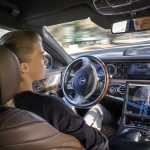 In the various discussions around the development of autonomous vehicle technology, one somewhat uncomfortable truth has been brushed under the carpet. There has been a prevailing assumption that once the technology is ready and the legislation arranged, that people will automatically choose the technology because it’s better, more efficient, safer, less polluting and so on.
In the various discussions around the development of autonomous vehicle technology, one somewhat uncomfortable truth has been brushed under the carpet. There has been a prevailing assumption that once the technology is ready and the legislation arranged, that people will automatically choose the technology because it’s better, more efficient, safer, less polluting and so on.
Alas, as new research from the University of Washington reminds us, many people actually enjoy driving, and losing that would be something they’re loathe to do.
The researchers examined how costly people tend to regard commuting time depending on who was doing the driving. The data revealed that people regard ride-hailing services, like Uber, as 13% ‘less expensive’, but if that same service was driverless, the perceived cost of travel rises by 15% over driving themselves.
“The idea here is that ‘time is money,’ so the overall cost of driving includes both the direct financial costs and the monetary equivalent of time spent traveling,” the authors say. “The average person in our sample would find riding in a driverless car to be more burdensome than driving themselves. This highlights the risks of making forecasts based on how people say they would respond to driverless cars today.”
Driverless premium
Researchers quizzed several hundred volunteers on their transport thoughts and preferences, with the responses then converted into a ‘cost per hour’ for each trip.
“If someone values their trip time at $15 per hour, that means they dislike an hour spent traveling as much as they dislike giving up $15,” the researchers explain. “So a lower number means that the time spent traveling for that trip is less burdensome.”
The data found that people nearly always preferred a ride-hailing service to driving themselves, with this especially so when participants were reminded that they could multi-task during their trip.
The interesting divergence however was when the car was driving itself. Technically, you would imagine the scores would be identical as the passenger can do just as much regardless of who’s driving the vehicle, but this didn’t appear to be the case at all.
The authors believe this is because of the uncertainty with which driverless technology is viewed, which is reflected in the scores people gave it.
“We believe that our respondents are telling us that if they were riding in an automated vehicle today, they would be sufficiently stressed out by the experience that it would be worse than driving themselves,” they conclude. “This is a reminder that automated vehicles will need to offer benefits to consumers before people will adopt them. To a first approximation, a ride-hailing service with driverless cars would need to offer services at a price at least $7 per hour less than human-driven cars, to make the driverless service more attractive.”
While we can reasonably expect the scores to change as people become more familiar with the technology, it’s a timely reminder that the industry cannot take unflinching passenger support for granted.